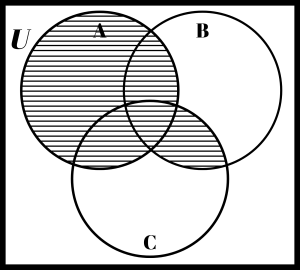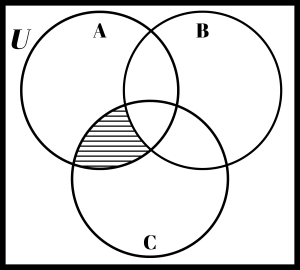9 Homework
Let U = {a, c, e, m n, r, u, v, w, x, z} with subsets A, B, C and D defined below: A = {m, n, r, u, x} B = { a, c, r, u, x} C = {e, v, w, x, z } D = {a, c, z} Using correct notation, find the following, show all work
| a. B ∩ D | f. A – Cc | k. (A ∩ D) – Bc |
| b. A ∩ D | g. B – (A ∩ C) | l. n(A ∪ B) |
| c. C – B | h. Dc – (B ∪ C) | m. n(A) + n(B) |
| d. (A ∪ C)c | i. (A ∩ B) ∩ (C ∪ D) | n. n(D – C) |
| e. Dc ∩ B | j. (Bc ∪ D)c | o. n(B ∩ C) |
Let U = {a, c, e, m, n, r, u, v, w, x, z} with subsets A, B, C defined as follows:
Draw a Venn Diagram and place each element of the universe in the correct region.
| A = {m, n, r, u, v} | B = {r, u, w, x} | C = {n, r, x, c} |
Use deMorgan’s Laws to rewrite each of the following:
| a. N ∪ Pc | b. Rc ∩ S |
Use the distributive properties of sets to rewrite each of the following:
| a. (Ac ∪ E) ∩ (Ac ∪ F) | b. B ∩ (A ∪ C) |
A survey was given to determine which of the three beverages (tea, milk, and/or coffee) people drank each day. The results were as follows:
| 7 only drank coffee | 6 drank all three | 11 drank tea and coffee |
| 21 drank coffee | 4 drank none of the three | 9 drank neither coffee nor tea |
| 21 drank tea | 1 drank only tea and milk |
| a. Draw a Venn diagram indicating how many people would belong in each region. Label the three sets with meaningful letters. |
| b. How many people were surveyed? |
| c. How many drank milk? |
| d. How many drank only coffee and milk? |
| e. How many drank only milk? |
| f. How many drank tea or coffee but not milk? |
| g. How many drank exactly two kinds of beverages? |
| h. How many didn’t drink milk or tea? |
Take out your A–blocks and arrange them into subsets so that each subset only contains elements that have the same size and color.
| a. How many subsets are there? __________ | b. How many pieces are in each subset? __________ |
Let A, B and C represent any sets. Answer True or False for the following statements. In order for a statement to be true, it must always be true. For each False statement, give an example of why it is False.
| a. B is always a subset of A ∪ B |
| b. (A – B)c = Ac – Bc |
| c. B is always a subset of A ∩ B |
| d. n(A ∪ B) = n(A) + n(B) |
| e. n(A ∪ B) = n(A) + n(B) – n(A ∩ B) |
| f. If n(A ∪ B) = n(A) + n(B), then A and B are disjoint. |
Draw a Venn diagram and shade in the region that represents the following
| a. (C ∪ A) – B | b. (C ∩ B) ∪ A | c. (C ∩ B) – A |
| d. (A ∪ C) ∩ B | e. A – (B ∩ C) | f. (B – A) ∩ (B – C) |
Identify the shaded area of each Venn diagram by set notation.
 |
 |
List all possible subsets for each set given.
| a. { } | b. {a} | c. {a, b} | d. {a, b, c} |
Let A = {1, 2, 4}, B = {(a, c), 5} and C = {x}. Find the following:
| a. A times A | b. A times B | c. B times C |
| d. C times A | e. C times C |
Use your A–blocks to do this problem. Let X represent the set of large circles and Y represent the set of red circles. Using set notation and abbreviations, find the following:
| a. X – Y | b. X ∩ Y | c. X ∪ Y | d. Y – X |
